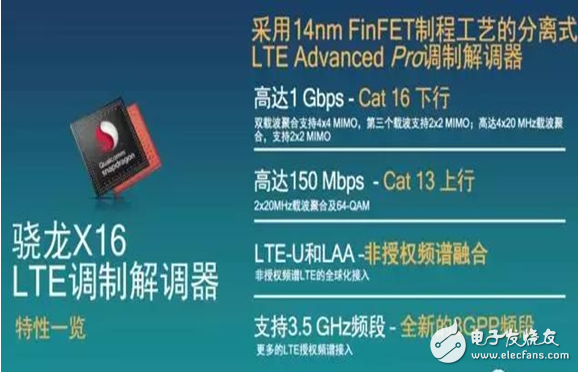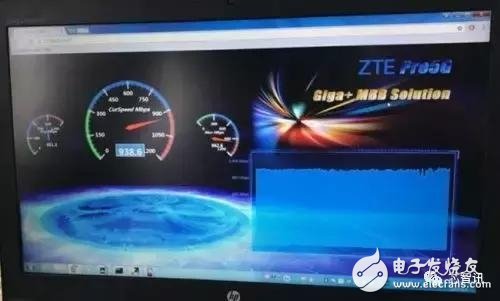Leading half a position on the 5G fast lane, relying on this!
In the past 30 years, mobile phones have connected people and people. The next 30 years are not only people, people, things, but people and things. At present, there are more than 7 billion people in the world. In the future, there will be more than 50 billion interconnected materials and equipment, which will generate huge amounts of data. These data need to rely on the network for transmission, and the traditional LTE network will be difficult to cope with such a huge amount. A surge in network traffic.
Cisco expects global mobile data traffic to reach 367.2 EB/year by 2020, corresponding to a compound growth rate of 53% for five years. The outbreak of traffic puts higher demands on the current network transmission rate. This has further promoted the development of 5G technology. Compared to 4G LTE technology, the peak rate of 5G will increase by tens of times, from several hundred Mb/s of 4G to tens of G/s. The number of user connections that can be supported can be increased to 1 million users per square kilometer, which can better meet the massive access scenarios such as the Internet of Things.
According to EU research, if all existing global networks are updated to 5G networks, it will have the capacity to access 7 trillion wireless devices and serve 7 billion people, which means that 5G networks will lay the foundation for the future Internet of Things industry. The foundation drives the market of trillions of scale. The industry generally believes that once the 5G network is officially commercialized, it will be expected to shake the Internet of Things industry with a scale of one trillion yuan. At the same time, it will greatly promote the development of artificial intelligence, driverless, intelligent manufacturing and other industries.
However, the current 5G standard has not yet been finalized, and related technologies are still immature. According to the timetable announced by the International Telecommunication Union, the 5G international standard will not be completed until 2020, so there is still a long way to go before 5G can be truly commercialized. Before that, we have embarked on 5G. In the transition phase, the main force of this phase will be Gigabit LTE.
The development of future 5G networks needs to make full use of existing 4G LTE networks, unlicensed spectrum and Wi-Fi networks. This also makes LTE technology still have considerable room for development. The current Gigabit LTE technology will become an important part of promoting 5G development. ABI Research believes that the introduction of 5G will be gradual, and LTE will remain the main force in at least 10 years in the future.
At present, several major communication companies have launched fierce competition for 5G Gigabit network technology standards. As the leader of the mobile network era, Qualcomm has already led the way in the 5G fast lane with its leading technology in Gigabit LTE.
At present, Qualcomm has continuously improved 4G with LTE Advanced, providing unprecedented data transfer rates, higher capacity and a new user experience. Moreover, Qualcomm's current focus is mainly on Gigabit LTE, and has repeatedly stated in public that this technology will play an important role before and after 5G commercial use. At the recent MWC Shanghai show, Qualcomm CEO Steve Morenkov stressed that before the 5G real arrival, 4G technology should be applied to the maximum, especially the new Gigabit LTE network.

As early as February 2016, Qualcomm released the Snapdragon X16 LTE modem, based on the latest 14nm FinFET process, and achieved the first amazing download speed of up to 1Gbps. The Snapdragon X16 LTE passed three-carrier aggregation, high-order modulation and 4X4. MIMO to achieve gigabit connectivity, Qualcomm called "the first Gigabit LTE chipset." And this Gigabit LTE modem has been integrated into Qualcomm's flagship mobile platform Snapdragon 835. At present, there are a number of commercial terminals based on the Snapdragon 835, such as the Samsung Galaxy S8/S8+.
In addition, in January of this year, Qualcomm also launched a new connected car reference platform based on the Opteron X16 LTE modem, which can support peak download speeds of up to 1 Gbps, helping automakers to provide leading in-vehicle information services and connected car service providers. High speed, quality and reliable connection required.
In fact, on the basis of the development of Gigabit LTE, Qualcomm has once again strengthened its own advantages this year. In February this year, it launched the second generation of Gigabit LTE modems - based on the 10 nanometer FinFET process technology. The X20 LTE chipset delivers LTE Category 18 download speeds of up to 1.2Gbps peak speed, up 20% from previous generations. According to Qualcomm, the Snapdragon X20 LTE modem is expected to be available in the first half of 2018.
Gigabit LTE will provide an exceptional next-generation mobile experience for the flagship consumer and enterprise-class mobile devices by providing fiber-like mobile networking speeds, such as a smooth 360°4K immersive virtual reality experience, and no local hard drive reading. Different cloud file reading speeds, networked cloud computing, multimedia online entertainment, instant APP applications and more. With the emergence of terminals and networks supporting Gigabit LTE, with the speed and network capacity enhancement, with the Qualcomm's Gigabit LTE modem, these use cases will have a better wireless connection experience. Gigabit wireless networks and terminal commercialization are important milestones in the world's 5G era.
Operators accelerate deployment of Gigabit LTE networksCurrently, 15 operators in more than 11 countries have planned or tested the deployment of Gigabit LTE networks. In addition, operators in 37 countries are experimenting with or deploying support modem features. For example, Telstra has teamed up with Ericsson and NETGEAR to provide Gigabit LTE services in Australia, while US carrier Sprint has begun deploying Gigabit networks in New Orleans, USA.

In addition to foreign operators, domestic operators in China are also actively deploying Gigabit LTE networks.
On June 16, China Unicom and Qualcomm jointly announced that through the cooperation of all parties, China Unicom will adopt the wireless network equipment of Ericsson and ZTE under the 4G+ network in Guangzhou and Quanzhou, and carry the Qualcomm Snapdragon 835 mobile platform and integrated Snapdragon X16. The Samsung Galaxy S8 smartphone with LTE modem has completed indoor and outdoor gigabit download rate verification, and the download rate has reached 966Mbps and 939Mbps respectively, successfully achieving gigabit data transmission rate. This is the first gigabit rate experience based on commercial networks and commercial terminals in China, and it is also the highest rate that commercial terminals can achieve. The commercial verification also marks the ability of China Unicom to have a commercial Gigabit network. It is understood that China Unicom has completed the pilot upgrade of the Gigabit network in several provinces and cities, and the Gigabit business is about to enter the commercial process.

Chi Yongsheng, vice president of China Unicom Network Technology Research Institute, said: "Gigabit LTE is a business manifestation of 5G technology 4G, and is also a milestone of 4G network 5G. China Unicom has been committed to the continuous evolution of network capabilities and the continuation of user experience. Enhance, while actively deploying 5G networks, it is also constantly improving 4G network capabilities to create the ultimate user experience."
On June 19, another Chinese mainstream operator, China Mobile, also joined hands with Qualcomm to announce its achievements in deploying Gigabit networks: China Mobile completed the first thousand commercial terminals in Zhejiang based on TD-LTE 4G+ network. Mega rate field test."
Test data shows that the downlink peak rate is above 700Mbps, and the average rate is about 680Mbps. According to reports, the terminal equipment used in this test is also a Samsung Galaxy S8/S8+ mobile phone equipped with Qualcomm Snapdragon 835 mobile platform, integrated with the Snapdragon X16 LTE modem, and China Mobile's implementation of the Gigabit LTE transmission speed utilizes three. The industry's most advanced connectivity technologies, such as carrier aggregation (CA), 4x4 MIMO, and 256-QAM, make wireless networks faster than wired networks.
It is no coincidence that China Mobile and China Unicom's two major Chinese operators have adopted terminals that integrate the Opteron X16 LTE modem in the Gigabit field test. On the other hand, it also confirms that Qualcomm provides Gigabit LTE. Modems play an indispensable role in driving network development.
In addition to the active promotion of Gigabit networks by operators, terminals supporting Gigabit LTE are also emerging. At present, Samsung, Xiaomi, Yijia, ZTE, HTC, Sony, and Motorola have all planned or announced mobile terminals supporting Gigabit LTE networks. In addition, Asustek, Hewlett-Packard, and Lenovo will also launch Windows 10 devices based on the Qualcomm Snapdragon 835 mobile PC platform, including the Snapdragon X16 LTE modem. With the increasing number of devices supporting Gigabit LTE networks, operators will further promote the construction of Gigabit LTE networks. Qualcomm's Gigabit LTE modems will undoubtedly play a key role in improving the user experience and driving ecosystem construction at this critical stage.
The deployment of 5G cannot be completed overnight, and it may take up to 2022 to achieve commercial scale. And now there will be a long period of nearly five years until 2022, during which the gigabit LTE network will provoke the gird. Even if 5G is widely used, LTE will not be completely replaced. LTE technology will continue to evolve and evolve. In the future of LTE and 5G coexistence and complementarity, perhaps as ABI Research puts it, "LTE will still be at least in the future. The main force in ten years, and this Gigabit LTE will provoke the girders. Compared to other competitors, Qualcomm's Gigabit LTE modems already have a first-mover advantage.
ZGAR Disposable Vape
ZGAR electronic cigarette uses high-tech R&D, food grade disposable pod device and high-quality raw material. All package designs are Original IP. Our designer team is from Hong Kong. We have very high requirements for product quality, flavors taste and packaging design. The E-liquid is imported, materials are food grade, and assembly plant is medical-grade dust-free workshops.
Our products include disposable e-cigarettes, rechargeable e-cigarettes, rechargreable disposable vape pen, and various of flavors of cigarette cartridges. From 600puffs to 5000puffs, ZGAR bar Disposable offer high-tech R&D, E-cigarette improves battery capacity, We offer various of flavors and support customization. And printing designs can be customized. We have our own professional team and competitive quotations for any OEM or ODM works.
We supply OEM rechargeable disposable vape pen,OEM disposable electronic cigarette,ODM disposable vape pen,ODM disposable electronic cigarette,OEM/ODM vape pen e-cigarette,OEM/ODM atomizer device.


Disposable E-cigarette, ODM disposable electronic cigarette, vape pen atomizer , Device E-cig, OEM disposable electronic cigarette
ZGAR INTERNATIONAL(HK)CO., LIMITED , https://www.sze-cigarette.com